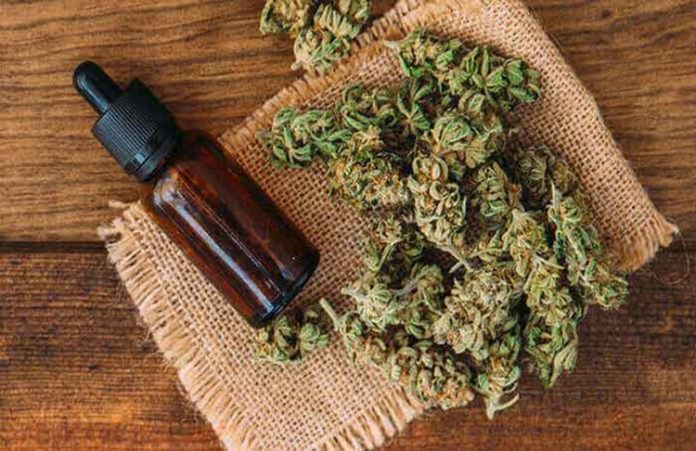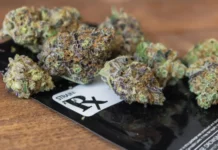Recently, at the end of a surf trip with several friends, my pal Tim passed me a pipe packed with sticky green buds. I’m not much of a social smoker (more of a one-hitter-before-chores type) so politely declined.
Then, he made an odd promise, for a guy brandishing a glass pipe and a lighter: “It won’t get you stoned,” he said. “It’s CBD.”
I took a little hit, and soon after, felt my body pleasantly melt into a lawn chair, my ability to socialize not at all impeded. Truth told, at the end of a physically exhausting vacation and a can of Tecate, I was already pretty relaxed. But the CBD seemed to deepen that state.
CBD is one of the many chemical compounds in a class called “cannabinoids” that naturally occur in cannabis plants. While THC is the most famous of cannabinoids for its ability to get us high, CBD is a rapidly rising star for its capacity to deliver mental and physical benefits without the giggles, paranoia, or couch-lock. Eaze, a marijuana delivery service that operates in California, reported an “exceptionally high” demand for CBD in 2017, which led the company to quadruple its product offerings in the category. Chris Kelly, a representative of Tikun Olam, an Israeli company at the forefront of medical marijuana, calls Avidekel—his employer’s highest-CBD strain—the “golden child” of its offerings. Rolling Stone deemed it one of the five best strains of 2017.
In addition to that good old “melting into a lawn chair” feeling, CBD’s reported benefits include relief from anxiety, joint pain, post-traumatic stress disorder, menstrual cramps, insomnia, nausea, seizures, bowel inflammation, and plain old moodiness. Today, adults in more than half of US states (and 16 countries worldwide) have legal access to marijuana for medical purposes, and it’s been legalized for recreational use in nine states, plus Washington, DC. As marijuana continues its march into the mainstream, CBD has emerged as an easy entryway for those who want to dip a toe into the wellness benefits of weed, but may be skeptical of getting stoned.
You can use it as a rub, or as a soak inside the tub
In the months since that first hit, I’ve tried out CBD in many forms. I’ve dropped tinctures under my tongue to help me sleep, whipped Whoopi and Maya’s CBD-enhanced raw cacao butter into hot milk to ease cramps (yes, that’s Whoopi as in Goldberg), and massaged Lord Jones’ piney scented CBD lotion into a stiff neck.
As with marijuana, the modes of consuming CBD are limited only by one’s imagination. Curious gourmands can sip it in a CBD-laced “Stoney Negroni” at the West Hollywood restaurant Gracias Madre, and aesthetes can rub it onto their lips via rose-scented balm. For a more traditional medicinal experience, CBD also comes in soft gel capsules, droppers, and sublingual sprays. (In more than 20 countries outside the US, one such spray is prescribed to multiple sclerosis patients who suffer from muscle spasms and stiffness.) And of course, since CBD is derived from the flowers of cannabis plants, one could just go ahead and smoke a high-CBD strain of marijuana the old-fashioned way, by rolling it into a joint or lighting up a bowl—or the new-fangled way, by vaping distilled cannabinoid oils in a Dosist vape pen that vibrates to alert the user they’ve reached the recommended dose.
How CBD works
Yu-Fung Lin, an associate professor of physiology and membrane biology at the University of California-Davis School of Medicine, teaches a course on the physiology of cannabis. She says although CBD is not considered to be psychotropic—meaning it won’t alter our perception of reality or produce a feeling of euphoria—it’s still working on our brains. CBD doesn’t activate our brains’ cannabinoid receptors in the same manner as THC, but it does target a wide variety of proteins in the brain and nervous system that regulate cell activities all over the human body. By interacting with the brain’s signaling systems in various ways, it can provide relief from pain, anxiety, and nausea. Beyond our brains, says Lin, CBD may benefit our bones and immune systems and work broadly throughout the body as an anti-inflammatory and antioxidant, which may help protect cells from damages associated with neurodegenerative diseases.
With these sorts of benefits, it’s little wonder that there’s a booming market for CBD—and readily willing suppliers promising miraculous results.
“CBD can be used to relieve multiple symptoms,” says Lin. “But you need to know what you are getting.”
To THC or not to THC
CBD products made from industrial hemp, which contains almost no THC (less than 0.3% in the US), are legal in all 50 US states. While many users report benefits of hemp-derived CBD—not the least of which is legality—some experts say a little THC helps CBD work in the body; that cannabis’ chemical compounds work better in tandem than in isolation.
This is often called the “entourage effect,” or as Lester Grinspoon, a psychiatrist and professor emeritus at Harvard Medical School calls it, the “ensemble effect.” (Like so much of the research surrounding cannabis, which is heavy on anecdotal evidence and light on hard science due to marijuana’s status as a Schedule I drug, the entourage effect is the source of healthy debate.)
“It’s a mixture of CBD, cannabidiol, THC, and the phytochemicals, the terpenoids,” Grinspoon tells High Times. “You need all three of them to get the best therapeutic effect.” For this reason, Grinspoon, Lin, and many others say that the best source for therapeutic CBD is a plant with all of its cannabinoids intact.
For the layperson with legal access to cannabis, the easiest of way of doing that is to visit a trustworthy dispensary, where you can ask for products derived from plants that have a high CBD-to-THC ratio. The aforementioned Avidekel, for example, is about 18:1. You can also ask for lab results that show the exact breakdown of a plant’s chemical compounds.
Like most medicines, CBD will have a different effect on everyone who uses it, so the best way to find out what works is simply to try it. Research shows minimal side effects, though some users have reported drowsiness and an upset stomach. Personally, I’ve once felt perhaps a little too relaxed after drinking a 20:1 CBD-enhanced hot cocoa to relieve excruciating cramps. But you know what? My muscles relaxed too.














